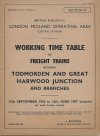Plodding my way through a book by Stuart Taylor he mentions coal for the power station at Wyre dock, Fleetwood.
He's the only one I've read that actually tells me why coal trains were heading there, I presumed as the place was a dock (and still is) that the coal was destined for ships maybe for other UK locations or export. I also forgot just how big a fishing port it was back in the day.
In my 1956 WTT covering Great Harwood Junction (Blackburn) to Colne and Todmorden I can see several coal trains on weekdays and Saturdays plus empties running back, but I'm struggling to spot the fish trains.
Here it is
I can see different classes of trains listed - can you tell me please which ones are likely to be fish trains?
Speaking of fish, I guess you probably need to move quickly to get it distributed. Would you send it to say Manchester first then outward to the surrounding towns? or would a train from the docks stop at town X, Y and then Z?
He's the only one I've read that actually tells me why coal trains were heading there, I presumed as the place was a dock (and still is) that the coal was destined for ships maybe for other UK locations or export. I also forgot just how big a fishing port it was back in the day.
In my 1956 WTT covering Great Harwood Junction (Blackburn) to Colne and Todmorden I can see several coal trains on weekdays and Saturdays plus empties running back, but I'm struggling to spot the fish trains.
Here it is
I can see different classes of trains listed - can you tell me please which ones are likely to be fish trains?
Speaking of fish, I guess you probably need to move quickly to get it distributed. Would you send it to say Manchester first then outward to the surrounding towns? or would a train from the docks stop at town X, Y and then Z?



